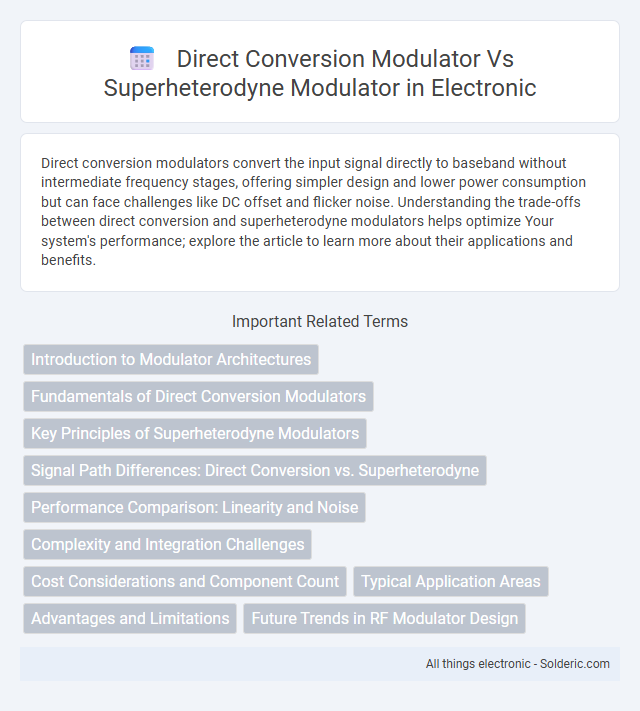Direct conversion modulators convert the input signal directly to baseband without intermediate frequency stages, offering simpler design and lower power consumption but can face challenges like DC offset and flicker noise. Understanding the trade-offs between direct conversion and superheterodyne modulators helps optimize Your system's performance; explore the article to learn more about their applications and benefits.
Comparison Table
| Feature | Direct Conversion Modulator | Superheterodyne Modulator |
|---|---|---|
| Architecture | Single-stage frequency translation directly to RF | Two-stage frequency conversion with intermediate frequency (IF) |
| Complexity | Simple, fewer components | Complex, more components including mixers and filters |
| Signal Purity | Potential DC offset and I/Q imbalance issues | Better image rejection and selectivity |
| Frequency Agility | Limited frequency tuning range | Wide tuning range due to IF stage |
| Power Consumption | Lower power consumption | Higher power consumption due to multiple stages |
| Use Cases | Low-cost, low-complexity RF transmitters | High-performance communications and radar systems |
Introduction to Modulator Architectures
Direct conversion modulators directly translate baseband signals to RF frequencies without intermediate frequency stages, resulting in simpler circuitry and reduced power consumption. Superheterodyne modulators utilize an intermediate frequency to improve selectivity and sensitivity, enhancing signal quality in complex environments. Choosing between these architectures depends on factors such as integration complexity, linearity requirements, and application-specific frequency ranges.
Fundamentals of Direct Conversion Modulators
Direct conversion modulators directly translate the baseband signal to the carrier frequency without intermediate frequency stages, reducing system complexity and size while minimizing phase noise and spurious emissions. This approach uses in-phase and quadrature mixers to perform simultaneous modulation of amplitude and phase, enhancing spectral efficiency and simplifying local oscillator requirements. Your design benefits from lower power consumption and easier integration in integrated circuits, though careful management of DC offset and I/Q imbalance is critical for optimal performance.
Key Principles of Superheterodyne Modulators
Superheterodyne modulators operate by mixing the input signal with a locally generated oscillator frequency to produce an intermediate frequency (IF) that simplifies filtering and amplification. This key principle enables improved selectivity and sensitivity compared to direct conversion modulators, which convert signals directly to baseband without an intermediate stage. Your system benefits from the superheterodyne approach through enhanced signal stability and reduced noise, critical for high-performance communication applications.
Signal Path Differences: Direct Conversion vs. Superheterodyne
Direct conversion modulators translate the input signal directly to baseband or the desired output frequency through a single mixing stage, minimizing intermediate frequency (IF) filtering and hardware complexity. Superheterodyne modulators use multiple frequency conversion stages, typically converting the input signal to an intermediate frequency before the final output frequency, which enhances selectivity and sensitivity by allowing optimized filtering at IF. The direct conversion path reduces components and latency but may suffer from DC offsets and I/Q imbalance, whereas superheterodyne architectures provide improved signal quality at the cost of increased complexity and power consumption.
Performance Comparison: Linearity and Noise
Direct conversion modulators offer superior linearity by directly converting the baseband signal to the desired frequency, minimizing signal distortion and intermodulation products. Superheterodyne modulators, while typically exhibiting lower phase noise due to intermediate frequency filtering, can introduce image frequency interference and require complex mixer linearity compensation. Noise performance in direct conversion is often limited by flicker noise and DC offset, whereas superheterodyne architectures benefit from frequency selectivity that reduces out-of-band noise, enhancing overall signal-to-noise ratio (SNR).
Complexity and Integration Challenges
Direct conversion modulators offer reduced complexity and easier integration due to fewer components and a simpler architecture, making them suitable for compact, low-power designs. Superheterodyne modulators involve multiple frequency stages and require complex filtering and mixing circuits, leading to higher integration challenges and increased design difficulty. Your choice depends on the trade-off between design simplicity and performance criteria like selectivity and sensitivity.
Cost Considerations and Component Count
Direct conversion modulators typically offer lower cost and reduced component count due to their simplified architecture, eliminating intermediate frequency stages and mixers. Superheterodyne modulators involve more complex circuitry, including local oscillators and multiple mixers, increasing both cost and component count. The streamlined design of direct conversion modulators also decreases power consumption and PCB space requirements, making them more cost-effective for many applications.
Typical Application Areas
Direct conversion modulators are commonly used in modern wireless communication systems such as LTE and 5G due to their simplified architecture and lower power consumption. Superheterodyne modulators find typical applications in traditional radio receivers, satellite communications, and radar systems where high sensitivity and selectivity are critical. Both modulator types play essential roles in software-defined radios and instrumentation, balancing performance requirements with design complexity.
Advantages and Limitations
Direct conversion modulators offer simpler circuit design and lower power consumption, making them ideal for compact and energy-efficient applications. Superheterodyne modulators provide superior selectivity and better sensitivity due to their frequency translation process, which reduces noise and enhances signal quality. Your choice depends on balancing the need for integration and simplicity versus performance and sensitivity in your communication system.
Future Trends in RF Modulator Design
Direct conversion modulators enable simplified architectures and improved integration for future RF systems, supporting trends toward software-defined radios and IoT devices. Superheterodyne modulators continue evolving with enhanced image rejection and frequency stability, addressing high-performance needs in 5G and beyond. Emerging designs prioritize low power consumption, scalability, and digital signal processing compatibility to meet expanding wireless communication demands.
Direct conversion modulator vs superheterodyne modulator Infographic

 solderic.com
solderic.com